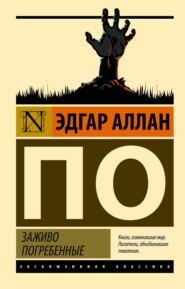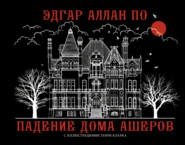По всем вопросам обращайтесь на: info@litportal.ru
(©) 2003-2025.
✖
The Works of Edgar Allan Poe — Volume 2
Настройки чтения
Размер шрифта
Высота строк
Поля
The visiter, shooting suddenly into this bay from out the gloom of the ravine, is delighted but astounded by the full orb of the declining sun, which he had supposed to be already far below the horizon, but which now confronts him, and forms the sole termination of an otherwise limitless vista seen through another chasm-like rift in the hills.
But here the voyager quits the vessel which has borne him so far, and descends into a light canoe of ivory, stained with arabesque devices in vivid scarlet, both within and without. The poop and beak of this boat arise high above the water, with sharp points, so that the general form is that of an irregular crescent. It lies on the surface of the bay with the proud grace of a swan. On its ermined floor reposes a single feathery paddle of satin-wood; but no oarsmen or attendant is to be seen. The guest is bidden to be of good cheer — that the fates will take care of him. The larger vessel disappears, and he is left alone in the canoe, which lies apparently motionless in the middle of the lake. While he considers what course to pursue, however, he becomes aware of a gentle movement in the fairy bark. It slowly swings itself around until its prow points toward the sun. It advances with a gentle but gradually accelerated velocity, while the slight ripples it creates seem to break about the ivory side in divinest melody-seem to offer the only possible explanation of the soothing yet melancholy music for whose unseen origin the bewildered voyager looks around him in vain.
The canoe steadily proceeds, and the rocky gate of the vista is approached, so that its depths can be more distinctly seen. To the right arise a chain of lofty hills rudely and luxuriantly wooded. It is observed, however, that the trait of exquisite cleanness where the bank dips into the water, still prevails. There is not one token of the usual river debris. To the left the character of the scene is softer and more obviously artificial. Here the bank slopes upward from the stream in a very gentle ascent, forming a broad sward of grass of a texture resembling nothing so much as velvet, and of a brilliancy of green which would bear comparison with the tint of the purest emerald. This plateau varies in width from ten to three hundred yards; reaching from the river-bank to a wall, fifty feet high, which extends, in an infinity of curves, but following the general direction of the river, until lost in the distance to the westward. This wall is of one continuous rock, and has been formed by cutting perpendicularly the once rugged precipice of the stream’s southern bank, but no trace of the labor has been suffered to remain. The chiselled stone has the hue of ages, and is profusely overhung and overspread with the ivy, the coral honeysuckle, the eglantine, and the clematis. The uniformity of the top and bottom lines of the wall is fully relieved by occasional trees of gigantic height, growing singly or in small groups, both along the plateau and in the domain behind the wall, but in close proximity to it; so that frequent limbs (of the black walnut especially) reach over and dip their pendent extremities into the water. Farther back within the domain, the vision is impeded by an impenetrable screen of foliage.
These things are observed during the canoe’s gradual approach to what I have called the gate of the vista. On drawing nearer to this, however, its chasm-like appearance vanishes; a new outlet from the bay is discovered to the left — in which direction the wall is also seen to sweep, still following the general course of the stream. Down this new opening the eye cannot penetrate very far; for the stream, accompanied by the wall, still bends to the left, until both are swallowed up by the leaves.
The boat, nevertheless, glides magically into the winding channel; and here the shore opposite the wall is found to resemble that opposite the wall in the straight vista. Lofty hills, rising occasionally into mountains, and covered with vegetation in wild luxuriance, still shut in the scene.
Floating gently onward, but with a velocity slightly augmented, the voyager, after many short turns, finds his progress apparently barred by a gigantic gate or rather door of burnished gold, elaborately carved and fretted, and reflecting the direct rays of the now fast-sinking sun with an effulgence that seems to wreath the whole surrounding forest in flames. This gate is inserted in the lofty wall; which here appears to cross the river at right angles. In a few moments, however, it is seen that the main body of the water still sweeps in a gentle and extensive curve to the left, the wall following it as before, while a stream of considerable volume, diverging from the principal one, makes its way, with a slight ripple, under the door, and is thus hidden from sight. The canoe falls into the lesser channel and approaches the gate. Its ponderous wings are slowly and musically expanded. The boat glides between them, and commences a rapid descent into a vast amphitheatre entirely begirt with purple mountains, whose bases are laved by a gleaming river throughout the full extent of their circuit. Meantime the whole Paradise of Arnheim bursts upon the view. There is a gush of entrancing melody; there is an oppressive sense of strange sweet odor, — there is a dream-like intermingling to the eye of tall slender Eastern trees — bosky shrubberies — flocks of golden and crimson birds — lily-fringed lakes — meadows of violets, tulips, poppies, hyacinths, and tuberoses — long intertangled lines of silver streamlets — and, upspringing confusedly from amid all, a mass of semi-Gothic, semi-Saracenic architecture sustaining itself by miracle in mid-air, glittering in the red sunlight with a hundred oriels, minarets, and pinnacles; and seeming the phantom handiwork, conjointly, of the Sylphs, of the Fairies, of the Genii and of the Gnomes.
LANDOR’S COTTAGE
A Pendant to “The Domain of Arnheim”
DURING A pedestrian trip last summer, through one or two of the river counties of New York, I found myself, as the day declined, somewhat embarrassed about the road I was pursuing. The land undulated very remarkably; and my path, for the last hour, had wound about and about so confusedly, in its effort to keep in the valleys, that I no longer knew in what direction lay the sweet village of B — , where I had determined to stop for the night. The sun had scarcely shone — strictly speaking — during the day, which nevertheless, had been unpleasantly warm. A smoky mist, resembling that of the Indian summer, enveloped all things, and of course, added to my uncertainty. Not that I cared much about the matter. If I did not hit upon the village before sunset, or even before dark, it was more than possible that a little Dutch farmhouse, or something of that kind, would soon make its appearance — although, in fact, the neighborhood (perhaps on account of being more picturesque than fertile) was very sparsely inhabited. At all events, with my knapsack for a pillow, and my hound as a sentry, a bivouac in the open air was just the thing which would have amused me. I sauntered on, therefore, quite at ease — Ponto taking charge of my gun — until at length, just as I had begun to consider whether the numerous little glades that led hither and thither, were intended to be paths at all, I was conducted by one of them into an unquestionable carriage track. There could be no mistaking it. The traces of light wheels were evident; and although the tall shrubberies and overgrown undergrowth met overhead, there was no obstruction whatever below, even to the passage of a Virginian mountain wagon — the most aspiring vehicle, I take it, of its kind. The road, however, except in being open through the wood — if wood be not too weighty a name for such an assemblage of light trees — and except in the particulars of evident wheel-tracks — bore no resemblance to any road I had before seen. The tracks of which I speak were but faintly perceptible — having been impressed upon the firm, yet pleasantly moist surface of — what looked more like green Genoese velvet than any thing else. It was grass, clearly — but grass such as we seldom see out of England — so short, so thick, so even, and so vivid in color. Not a single impediment lay in the wheel-route — not even a chip or dead twig. The stones that once obstructed the way had been carefully placed — not thrown-along the sides of the lane, so as to define its boundaries at bottom with a kind of half-precise, half-negligent, and wholly picturesque definition. Clumps of wild flowers grew everywhere, luxuriantly, in the interspaces.
What to make of all this, of course I knew not. Here was art undoubtedly — that did not surprise me — all roads, in the ordinary sense, are works of art; nor can I say that there was much to wonder at in the mere excess of art manifested; all that seemed to have been done, might have been done here — with such natural “capabilities” (as they have it in the books on Landscape Gardening) — with very little labor and expense. No; it was not the amount but the character of the art which caused me to take a seat on one of the blossomy stones and gaze up and down this fairy-like avenue for half an hour or more in bewildered admiration. One thing became more and more evident the longer I gazed: an artist, and one with a most scrupulous eye for form, had superintended all these arrangements. The greatest care had been taken to preserve a due medium between the neat and graceful on the one hand, and the pittoresque, in the true sense of the Italian term, on the other. There were few straight, and no long uninterrupted lines. The same effect of curvature or of color appeared twice, usually, but not oftener, at any one point of view. Everywhere was variety in uniformity. It was a piece of “composition,” in which the most fastidiously critical taste could scarcely have suggested an emendation.
I had turned to the right as I entered this road, and now, arising, I continued in the same direction. The path was so serpentine, that at no moment could I trace its course for more than two or three paces in advance. Its character did not undergo any material change.
Presently the murmur of water fell gently upon my ear — and in a few moments afterward, as I turned with the road somewhat more abruptly than hitherto, I became aware that a building of some kind lay at the foot of a gentle declivity just before me. I could see nothing distinctly on account of the mist which occupied all the little valley below. A gentle breeze, however, now arose, as the sun was about descending; and while I remained standing on the brow of the slope, the fog gradually became dissipated into wreaths, and so floated over the scene.
As it came fully into view — thus gradually as I describe it — piece by piece, here a tree, there a glimpse of water, and here again the summit of a chimney, I could scarcely help fancying that the whole was one of the ingenious illusions sometimes exhibited under the name of “vanishing pictures.”
By the time, however, that the fog had thoroughly disappeared, the sun had made its way down behind the gentle hills, and thence, as if with a slight chassez to the south, had come again fully into sight, glaring with a purplish lustre through a chasm that entered the valley from the west. Suddenly, therefore — and as if by the hand of magic — this whole valley and every thing in it became brilliantly visible.
The first coup d’oeil, as the sun slid into the position described, impressed me very much as I have been impressed, when a boy, by the concluding scene of some well-arranged theatrical spectacle or melodrama. Not even the monstrosity of color was wanting; for the sunlight came out through the chasm, tinted all orange and purple; while the vivid green of the grass in the valley was reflected more or less upon all objects from the curtain of vapor that still hung overhead, as if loth to take its total departure from a scene so enchantingly beautiful.
The little vale into which I thus peered down from under the fog canopy could not have been more than four hundred yards long; while in breadth it varied from fifty to one hundred and fifty or perhaps two hundred. It was most narrow at its northern extremity, opening out as it tended southwardly, but with no very precise regularity. The widest portion was within eighty yards of the southern extreme. The slopes which encompassed the vale could not fairly be called hills, unless at their northern face. Here a precipitous ledge of granite arose to a height of some ninety feet; and, as I have mentioned, the valley at this point was not more than fifty feet wide; but as the visiter proceeded southwardly from the cliff, he found on his right hand and on his left, declivities at once less high, less precipitous, and less rocky. All, in a word, sloped and softened to the south; and yet the whole vale was engirdled by eminences, more or less high, except at two points. One of these I have already spoken of. It lay considerably to the north of west, and was where the setting sun made its way, as I have before described, into the amphitheatre, through a cleanly cut natural cleft in the granite embankment; this fissure might have been ten yards wide at its widest point, so far as the eye could trace it. It seemed to lead up, up like a natural causeway, into the recesses of unexplored mountains and forests. The other opening was directly at the southern end of the vale. Here, generally, the slopes were nothing more than gentle inclinations, extending from east to west about one hundred and fifty yards. In the middle of this extent was a depression, level with the ordinary floor of the valley. As regards vegetation, as well as in respect to every thing else, the scene softened and sloped to the south. To the north — on the craggy precipice — a few paces from the verge — up sprang the magnificent trunks of numerous hickories, black walnuts, and chestnuts, interspersed with occasional oak, and the strong lateral branches thrown out by the walnuts especially, spread far over the edge of the cliff. Proceeding southwardly, the explorer saw, at first, the same class of trees, but less and less lofty and Salvatorish in character; then he saw the gentler elm, succeeded by the sassafras and locust — these again by the softer linden, red-bud, catalpa, and maple — these yet again by still more graceful and more modest varieties. The whole face of the southern declivity was covered with wild shrubbery alone — an occasional silver willow or white poplar excepted. In the bottom of the valley itself — (for it must be borne in mind that the vegetation hitherto mentioned grew only on the cliffs or hillsides) — were to be seen three insulated trees. One was an elm of fine size and exquisite form: it stood guard over the southern gate of the vale. Another was a hickory, much larger than the elm, and altogether a much finer tree, although both were exceedingly beautiful: it seemed to have taken charge of the northwestern entrance, springing from a group of rocks in the very jaws of the ravine, and throwing its graceful body, at an angle of nearly forty-five degrees, far out into the sunshine of the amphitheatre. About thirty yards east of this tree stood, however, the pride of the valley, and beyond all question the most magnificent tree I have ever seen, unless, perhaps, among the cypresses of the Itchiatuckanee. It was a triple-stemmed tulip-tree — the Liriodendron Tulipiferum — one of the natural order of magnolias. Its three trunks separated from the parent at about three feet from the soil, and diverging very slightly and gradually, were not more than four feet apart at the point where the largest stem shot out into foliage: this was at an elevation of about eighty feet. The whole height of the principal division was one hundred and twenty feet. Nothing can surpass in beauty the form, or the glossy, vivid green of the leaves of the tulip-tree. In the present instance they were fully eight inches wide; but their glory was altogether eclipsed by the gorgeous splendor of the profuse blossoms. Conceive, closely congregated, a million of the largest and most resplendent tulips! Only thus can the reader get any idea of the picture I would convey. And then the stately grace of the clean, delicately-granulated columnar stems, the largest four feet in diameter, at twenty from the ground. The innumerable blossoms, mingling with those of other trees scarcely less beautiful, although infinitely less majestic, filled the valley with more than Arabian perfumes.
The general floor of the amphitheatre was grass of the same character as that I had found in the road; if anything, more deliciously soft, thick, velvety, and miraculously green. It was hard to conceive how all this beauty had been attained.
I have spoken of two openings into the vale. From the one to the northwest issued a rivulet, which came, gently murmuring and slightly foaming, down the ravine, until it dashed against the group of rocks out of which sprang the insulated hickory. Here, after encircling the tree, it passed on a little to the north of east, leaving the tulip tree some twenty feet to the south, and making no decided alteration in its course until it came near the midway between the eastern and western boundaries of the valley. At this point, after a series of sweeps, it turned off at right angles and pursued a generally southern direction meandering as it went — until it became lost in a small lake of irregular figure (although roughly oval), that lay gleaming near the lower extremity of the vale. This lakelet was, perhaps, a hundred yards in diameter at its widest part. No crystal could be clearer than its waters. Its bottom, which could be distinctly seen, consisted altogether, of pebbles brilliantly white. Its banks, of the emerald grass already described, rounded, rather than sloped, off into the clear heaven below; and so clear was this heaven, so perfectly, at times, did it reflect all objects above it, that where the true bank ended and where the mimic one commenced, it was a point of no little difficulty to determine. The trout, and some other varieties of fish, with which this pond seemed to be almost inconveniently crowded, had all the appearance of veritable flying-fish. It was almost impossible to believe that they were not absolutely suspended in the air. A light birch canoe that lay placidly on the water, was reflected in its minutest fibres with a fidelity unsurpassed by the most exquisitely polished mirror. A small island, fairly laughing with flowers in full bloom, and affording little more space than just enough for a picturesque little building, seemingly a fowl-house — arose from the lake not far from its northern shore — to which it was connected by means of an inconceivably light-looking and yet very primitive bridge. It was formed of a single, broad and thick plank of the tulip wood. This was forty feet long, and spanned the interval between shore and shore with a slight but very perceptible arch, preventing all oscillation. From the southern extreme of the lake issued a continuation of the rivulet, which, after meandering for, perhaps, thirty yards, finally passed through the “depression” (already described) in the middle of the southern declivity, and tumbling down a sheer precipice of a hundred feet, made its devious and unnoticed way to the Hudson.
The lake was deep — at some points thirty feet — but the rivulet seldom exceeded three, while its greatest width was about eight. Its bottom and banks were as those of the pond — if a defect could have been attributed, in point of picturesqueness, it was that of excessive neatness.
The expanse of the green turf was relieved, here and there, by an occasional showy shrub, such as the hydrangea, or the common snowball, or the aromatic seringa; or, more frequently, by a clump of geraniums blossoming gorgeously in great varieties. These latter grew in pots which were carefully buried in the soil, so as to give the plants the appearance of being indigenous. Besides all this, the lawn’s velvet was exquisitely spotted with sheep — a considerable flock of which roamed about the vale, in company with three tamed deer, and a vast number of brilliantly-plumed ducks. A very large mastiff seemed to be in vigilant attendance upon these animals, each and all.
Along the eastern and western cliffs — where, toward the upper portion of the amphitheatre, the boundaries were more or less precipitous — grew ivy in great profusion — so that only here and there could even a glimpse of the naked rock be obtained. The northern precipice, in like manner, was almost entirely clothed by grape-vines of rare luxuriance; some springing from the soil at the base of the cliff, and others from ledges on its face.
The slight elevation which formed the lower boundary of this little domain, was crowned by a neat stone wall, of sufficient height to prevent the escape of the deer. Nothing of the fence kind was observable elsewhere; for nowhere else was an artificial enclosure needed: — any stray sheep, for example, which should attempt to make its way out of the vale by means of the ravine, would find its progress arrested, after a few yards’ advance, by the precipitous ledge of rock over which tumbled the cascade that had arrested my attention as I first drew near the domain. In short, the only ingress or egress was through a gate occupying a rocky pass in the road, a few paces below the point at which I stopped to reconnoitre the scene.
I have described the brook as meandering very irregularly through the whole of its course. Its two general directions, as I have said, were first from west to east, and then from north to south. At the turn, the stream, sweeping backward, made an almost circular loop, so as to form a peninsula which was very nearly an island, and which included about the sixteenth of an acre. On this peninsula stood a dwelling-house — and when I say that this house, like the infernal terrace seen by Vathek, “etait d’une architecture inconnue dans les annales de la terre,” I mean, merely, that its tout ensemble struck me with the keenest sense of combined novelty and propriety — in a word, of poetry — (for, than in the words just employed, I could scarcely give, of poetry in the abstract, a more rigorous definition) — and I do not mean that merely outre was perceptible in any respect.
In fact nothing could well be more simple — more utterly unpretending than this cottage. Its marvellous effect lay altogether in its artistic arrangement as a picture. I could have fancied, while I looked at it, that some eminent landscape-painter had built it with his brush.
The point of view from which I first saw the valley, was not altogether, although it was nearly, the best point from which to survey the house. I will therefore describe it as I afterwards saw it — from a position on the stone wall at the southern extreme of the amphitheatre.
The main building was about twenty-four feet long and sixteen broad — certainly not more. Its total height, from the ground to the apex of the roof, could not have exceeded eighteen feet. To the west end of this structure was attached one about a third smaller in all its proportions: — the line of its front standing back about two yards from that of the larger house, and the line of its roof, of course, being considerably depressed below that of the roof adjoining. At right angles to these buildings, and from the rear of the main one — not exactly in the middle — extended a third compartment, very small — being, in general, one-third less than the western wing. The roofs of the two larger were very steep — sweeping down from the ridge-beam with a long concave curve, and extending at least four feet beyond the walls in front, so as to form the roofs of two piazzas. These latter roofs, of course, needed no support; but as they had the air of needing it, slight and perfectly plain pillars were inserted at the corners alone. The roof of the northern wing was merely an extension of a portion of the main roof. Between the chief building and western wing arose a very tall and rather slender square chimney of hard Dutch bricks, alternately black and red: — a slight cornice of projecting bricks at the top. Over the gables the roofs also projected very much: — in the main building about four feet to the east and two to the west. The principal door was not exactly in the main division, being a little to the east — while the two windows were to the west. These latter did not extend to the floor, but were much longer and narrower than usual — they had single shutters like doors — the panes were of lozenge form, but quite large. The door itself had its upper half of glass, also in lozenge panes — a movable shutter secured it at night. The door to the west wing was in its gable, and quite simple — a single window looked out to the south. There was no external door to the north wing, and it also had only one window to the east.
The blank wall of the eastern gable was relieved by stairs (with a balustrade) running diagonally across it — the ascent being from the south. Under cover of the widely projecting eave these steps gave access to a door leading to the garret, or rather loft — for it was lighted only by a single window to the north, and seemed to have been intended as a store-room.
The piazzas of the main building and western wing had no floors, as is usual; but at the doors and at each window, large, flat irregular slabs of granite lay imbedded in the delicious turf, affording comfortable footing in all weather. Excellent paths of the same material — not nicely adapted, but with the velvety sod filling frequent intervals between the stones, led hither and thither from the house, to a crystal spring about five paces off, to the road, or to one or two out-houses that lay to the north, beyond the brook, and were thoroughly concealed by a few locusts and catalpas.
Not more than six steps from the main door of the cottage stood the dead trunk of a fantastic pear-tree, so clothed from head to foot in the gorgeous bignonia blossoms that one required no little scrutiny to determine what manner of sweet thing it could be. From various arms of this tree hung cages of different kinds. In one, a large wicker cylinder with a ring at top, revelled a mocking bird; in another an oriole; in a third the impudent bobolink — while three or four more delicate prisons were loudly vocal with canaries.
The pillars of the piazza were enwreathed in jasmine and sweet honeysuckle; while from the angle formed by the main structure and its west wing, in front, sprang a grape-vine of unexampled luxuriance. Scorning all restraint, it had clambered first to the lower roof — then to the higher; and along the ridge of this latter it continued to writhe on, throwing out tendrils to the right and left, until at length it fairly attained the east gable, and fell trailing over the stairs.
The whole house, with its wings, was constructed of the old-fashioned Dutch shingles — broad, and with unrounded corners. It is a peculiarity of this material to give houses built of it the appearance of being wider at bottom than at top — after the manner of Egyptian architecture; and in the present instance, this exceedingly picturesque effect was aided by numerous pots of gorgeous flowers that almost encompassed the base of the buildings.
The shingles were painted a dull gray; and the happiness with which this neutral tint melted into the vivid green of the tulip tree leaves that partially overshadowed the cottage, can readily be conceived by an artist.
From the position near the stone wall, as described, the buildings were seen at great advantage — for the southeastern angle was thrown forward — so that the eye took in at once the whole of the two fronts, with the picturesque eastern gable, and at the same time obtained just a sufficient glimpse of the northern wing, with parts of a pretty roof to the spring-house, and nearly half of a light bridge that spanned the brook in the near vicinity of the main buildings.
I did not remain very long on the brow of the hill, although long enough to make a thorough survey of the scene at my feet. It was clear that I had wandered from the road to the village, and I had thus good traveller’s excuse to open the gate before me, and inquire my way, at all events; so, without more ado, I proceeded.
The road, after passing the gate, seemed to lie upon a natural ledge, sloping gradually down along the face of the north-eastern cliffs. It led me on to the foot of the northern precipice, and thence over the bridge, round by the eastern gable to the front door. In this progress, I took notice that no sight of the out-houses could be obtained.
As I turned the corner of the gable, the mastiff bounded towards me in stern silence, but with the eye and the whole air of a tiger. I held him out my hand, however, in token of amity — and I never yet knew the dog who was proof against such an appeal to his courtesy. He not only shut his mouth and wagged his tail, but absolutely offered me his paw — afterward extending his civilities to Ponto.
As no bell was discernible, I rapped with my stick against the door, which stood half open. Instantly a figure advanced to the threshold — that of a young woman about twenty-eight years of age — slender, or rather slight, and somewhat above the medium height. As she approached, with a certain modest decision of step altogether indescribable. I said to myself, “Surely here I have found the perfection of natural, in contradistinction from artificial grace.” The second impression which she made on me, but by far the more vivid of the two, was that of enthusiasm. So intense an expression of romance, perhaps I should call it, or of unworldliness, as that which gleamed from her deep-set eyes, had never so sunk into my heart of hearts before. I know not how it is, but this peculiar expression of the eye, wreathing itself occasionally into the lips, is the most powerful, if not absolutely the sole spell, which rivets my interest in woman. “Romance,” provided my readers fully comprehended what I would here imply by the word — “romance” and “womanliness” seem to me convertible terms: and, after all, what man truly loves in woman, is simply her womanhood. The eyes of Annie (I heard some one from the interior call her “Annie, darling!”) were “spiritual grey;” her hair, a light chestnut: this is all I had time to observe of her.
At her most courteous of invitations, I entered — passing first into a tolerably wide vestibule. Having come mainly to observe, I took notice that to my right as I stepped in, was a window, such as those in front of the house; to the left, a door leading into the principal room; while, opposite me, an open door enabled me to see a small apartment, just the size of the vestibule, arranged as a study, and having a large bow window looking out to the north.
Passing into the parlor, I found myself with Mr. Landor — for this, I afterwards found, was his name. He was civil, even cordial in his manner, but just then, I was more intent on observing the arrangements of the dwelling which had so much interested me, than the personal appearance of the tenant.
The north wing, I now saw, was a bed-chamber, its door opened into the parlor. West of this door was a single window, looking toward the brook. At the west end of the parlor, were a fireplace, and a door leading into the west wing — probably a kitchen.
Nothing could be more rigorously simple than the furniture of the parlor. On the floor was an ingrain carpet, of excellent texture — a white ground, spotted with small circular green figures. At the windows were curtains of snowy white jaconet muslin: they were tolerably full, and hung decisively, perhaps rather formally in sharp, parallel plaits to the floor — just to the floor. The walls were prepared with a French paper of great delicacy, a silver ground, with a faint green cord running zig-zag throughout. Its expanse was relieved merely by three of Julien’s exquisite lithographs a trois crayons, fastened to the wall without frames. One of these drawings was a scene of Oriental luxury, or rather voluptuousness; another was a “carnival piece,” spirited beyond compare; the third was a Greek female head — a face so divinely beautiful, and yet of an expression so provokingly indeterminate, never before arrested my attention.
The more substantial furniture consisted of a round table, a few chairs (including a large rocking-chair), and a sofa, or rather “settee;” its material was plain maple painted a creamy white, slightly interstriped with green; the seat of cane. The chairs and table were “to match,” but the forms of all had evidently been designed by the same brain which planned “the grounds;” it is impossible to conceive anything more graceful.
On the table were a few books, a large, square, crystal bottle of some novel perfume, a plain ground-glass astral (not solar) lamp with an Italian shade, and a large vase of resplendently-blooming flowers. Flowers, indeed, of gorgeous colours and delicate odour formed the sole mere decoration of the apartment. The fire-place was nearly filled with a vase of brilliant geranium. On a triangular shelf in each angle of the room stood also a similar vase, varied only as to its lovely contents. One or two smaller bouquets adorned the mantel, and late violets clustered about the open windows.
It is not the purpose of this work to do more than give in detail, a picture of Mr. Landor’s residence — as I found it. How he made it what it was — and why — with some particulars of Mr. Landor himself — may, possibly form the subject of another article.
WILLIAM WILSON
What say of it? what say of CONSCIENCE grim,
That spectre in my path?
Chamberlayne’s Pharronida.
LET me call myself, for the present, William Wilson. The fair page now lying before me need not be sullied with my real appellation. This has been already too much an object for the scorn — for the horror — for the detestation of my race. To the uttermost regions of the globe have not the indignant winds bruited its unparalleled infamy? Oh, outcast of all outcasts most abandoned! — to the earth art thou not forever dead? to its honors, to its flowers, to its golden aspirations? — and a cloud, dense, dismal, and limitless, does it not hang eternally between thy hopes and heaven?
I would not, if I could, here or to-day, embody a record of my later years of unspeakable misery, and unpardonable crime. This epoch — these later years — took unto themselves a sudden elevation in turpitude, whose origin alone it is my present purpose to assign. Men usually grow base by degrees. From me, in an instant, all virtue dropped bodily as a mantle. From comparatively trivial wickedness I passed, with the stride of a giant, into more than the enormities of an Elah-Gabalus. What chance — what one event brought this evil thing to pass, bear with me while I relate. Death approaches; and the shadow which foreruns him has thrown a softening influence over my spirit. I long, in passing through the dim valley, for the sympathy — I had nearly said for the pity — of my fellow men. I would fain have them believe that I have been, in some measure, the slave of circumstances beyond human control. I would wish them to seek out for me, in the details I am about to give, some little oasis of fatality amid a wilderness of error. I would have them allow — what they cannot refrain from allowing — that, although temptation may have erewhile existed as great, man was never thus, at least, tempted before — certainly, never thus fell. And is it therefore that he has never thus suffered? Have I not indeed been living in a dream? And am I not now dying a victim to the horror and the mystery of the wildest of all sublunary visions?

















